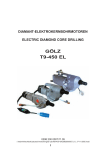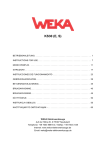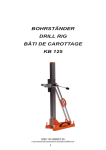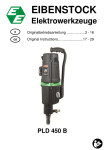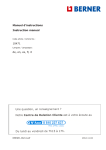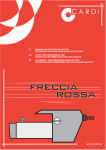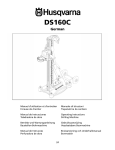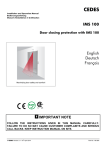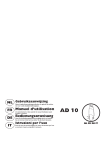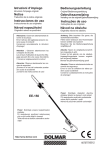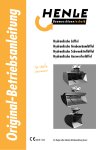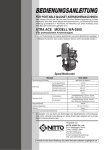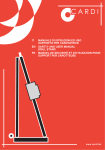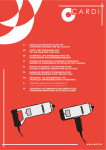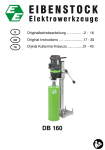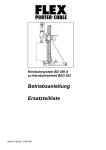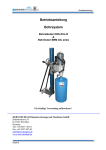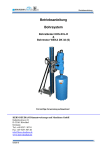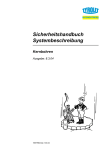Download Mode d'emploi Instruction manual de, en, fr, it
Transcript
Mode d'emploi Instruction manual Talen / Langues / Languages: de, en, fr, it BERNER_64269.pdf 2013-05-23 IT EN FR DE MANUALE DI ISTRUZIONI ED USO SUPPORTO PER CAROTATRICE SAFETY AND USER MANUAL DRILL STAND MANUEL DE SÉCURITÉ ET D'UTILISATION POUR: SUPPORT PER CAROTTEUSE SICHERHEITS- UND BETRIEBSANLEITUNG FÜR: BOHRSTÄNDER 1 X + Y + Z 2 B C E D A G 3 F B Q C D E A 4 I H L L G L L R 5 N P O M 5/A 5/B 5/C 5/D 6 7 8 9 10 11 T S S 1 Italiano Il vostro supporto per carotatrice Berner (X) è un dispositivo che deve essere usato in combinazione con un motoriduttore idoneo (Z) e un sistema di ancoraggio (Y) idoneo, secondo le indicazioni fornite in questo manuale. Questi tre elementi formano una carotatrice (X+Y+Z), adatta all’esecuzione di fori su materiali lapidei (es.: mattoni, muratura, pietra naturale), utilizzando una corona diamantata. Il supporto rispetta le normative relative alle carotatrici quando impiegato nei limiti precisati in questo manuale. Attenzione: assicurarsi che tutti i componenti della carotatrice siano idonei all’esecuzione del foro che si sta per effettuare, sia in termini di diametro che di profondità, in relazione al materiale da forare. In caso di dubbio rivolgersi al rivenditore. Norme di sicurezza generale ATTENZIONE! Leggere attentamente le seguenti istruzioni prima di utilizzare il prodotto. CONSERVARE QUESTE ISTRUZIONI Leggere le istruzioni di sicurezza fornite dal produttore del motoriduttore e del sistema di ancoraggio prima di utilizzare il vostro supporto. a) Tenere pulita l'area di lavoro. Ambienti e banchi di lavoro in disordine possono essere causa di incidenti. b) Tenere lontani i bambini. Non permettere che persone estranee tocchino l'utensile o gli accessori. Tenere i non addetti ai lavori lontani dal posto di lavoro. c) Usare un vestiario appropriato. Evitare l'uso di abiti svolazzanti, catenine, ecc., in quanto potrebbero rimanere presi nelle parti mobili dell'utensile. Lavorando all'aperto indossare guanti di gomma e scarpe con suole antisdrucciolo. Raccogliere i capelli se si portano lunghi. d) Usare occhiali protettivi. Usare inoltre una maschera antipolvere qualora si producano polvere o particelle volatili. e) Rumorosità eccessiva. Prendere appropriate misure a protezione dell'udito se il livello acustico supera gli 85 dB. f) Stare sempre attenti. Prestare attenzione a quanto si sta facendo. Usare il proprio buon senso. Non utilizzare l’utensile se si è stanchi. g) Usare l'utensile adatto. L'utilizzo previsto è indicato nel presente manuale. Non forzare utensili e accessori di potenza limitata impiegandoli per lavori destinati ad utensili di maggiore potenza. Attenzione: l'uso di accessori o attrezzature diversi, o l'impiego del presente utensile per scopi diversi da quelli raccomandati nel manuale uso possono comportare il rischio di infortuni. h) Rivolgersi ai Centri di Assistenza Tecnica autorizzati BERNER per le riparazioni. Disposizioni di sicurezza per carotatrici Indossare sempre occhiali protettivi Indossare guanti protettivi Indossare calzature protettive Indossare maschere antipolvere Indossare sempre protezioni per l’udito Istruzioni Leggere attentamente i dati riportati nella scheda Dati tecnici fornita con il prodotto. Per le illustrazioni si faccia riferimento alle pagine iniziali di questo manuale. Nel testo che segue le figure sono identificate da numeri mentre i singoli particolari, all'interno delle figure, sono identificati da lettere. Il supporto Il supporto è costituito dai seguenti elementi, rappresentati nel generico supporto in figura 2 e 3. una base (A). La base permette l’ancoraggio del supporto alla superficie da forare. Successivamente verranno descritte le diverse modalità di ancoraggio in relazione al tipo di supporto; una colonna (B). La colonna è la struttura dotata di cremagliera che permette alla slitta (C) di scorrere; una slitta (C). La slitta è la parte mobile del supporto che si interfaccia con il motoriduttore. Alla slitta viene ancorato il volantino di avanzamento (E) per permetterne lo spostamento; barre di rinforzo (D). Collegano la sommità del supporto alla base per dare rigidità al sistema. Le barre di rinforzo sono opzionali in alcune tipologie di supporti; manicotto di contrasto (F), previsto solo per alcune tipologie di supporti; cerca centro – guida corona (G). Permette di stabilire con precisione il centro del foro e di guidare la corona nelle fasi di inizio carotaggio. Ancoraggio del supporto Attenzione: per la vostra sicurezza è importante che il supporto sia adeguatamente e saldamente ancorato durante la foratura. Attenzione: individuare sempre l’area di caduta della carotatrice nel caso in cui il supporto si distacchi dagli ancoraggi: non stare in questa area ed evitare che chiunque possa stare in questa area o attraversarla. Questo in particolare nel caso si fori orizzontalmente o sottotesta. Un corretto ancoraggio del supporto garantisce, oltre che la sicurezza, anche alte prestazioni di foratura, alta qualità del foro, un ridotto consumo di corone e un ridotto sforzo del motoriduttore. Il vostro supporto, a seconda della tipologia, può supportare diverse modalità di ancoraggio qui di seguito illustrate. Ancoraggio con tassello Il supporto può essere ancorato utilizzando varie tipologie di tassello a seconda del materiale. Questo sistema è molto efficace ma poco rapido in quanto richiede almeno un tassello di ancoraggio. Attenzione: per la vostra sicurezza, assicurarsi sempre che il materiale nel quale si posiziona il tassello e il tassello stesso abbiano la resistenza meccanica sufficiente per trattenere Italiano il sistema. A volte sono necessari due tasselli. In ogni caso il filetto del tassello deve essere almeno M12. Leggere sempre le istruzioni fornite dal produttore del tassello e verificare che il tassello sia adatto all’uso. Per l’ancoraggio tramite tassello seguire queste istruzioni: dopo aver definito la posizione del foro da effettuare, individuare la posizione del foro per il tassello. L’ancoraggio è tanto migliore quanto più il tassello è vicino alla colonna; scegliere il tassello adatto all’applicazione con filetto del tassello almeno M12; effettuare il foro per il tassello di dimensione adatta e fissare il tassello al materiale, quindi avvitare nel tassello una barra filettata adatta; posizionare il supporto inserendo la barra filettata (figura 4 I) nell’asola della base (H). Fissare quindi il supporto con un dado adatto, interponendo la rondella fornita, così come rappresentato in figura 4, in modo che la rondella si impegni sulla base; se necessario, utilizzare le quattro viti indicate nelle figure con la lettera L per livellare la base e assicurare la stabilità della colonna. Tasselli ad espansione per il fissaggio dei supporti BERNER sono disponibili come accessori. Ancoraggio a vuoto L’ancoraggio a vuoto è possibile se il vostro supporto è provvisto di una base predisposta come da figura 5 oppure con appositi accessori. Ancorare a vuoto significa che il supporto è fissato al materiale dal vuoto creato da una pompa a vuoto. Questo fissaggio è rapido ed economico, ma richiede una superficie di ancoraggio: adeguatamente liscia, pulita e priva di detriti, per evitare rientri di aria; sufficientemente compatta, per evitare il distacco dello strato esterno della superficie stessa (intonaco male ancorato, piastrelle a parete incollate o male fissate). In caso di superficie compatta, ma che presenti delle asperità o degli avvallamenti, provvedere a livellarla il più possibile, rimovendo le asperità o applicando un leggero strato di gesso a presa rapida sugli avvallamenti in corrispondenza della guarnizione della base. Attenzione: individuare sempre l’area di caduta della carotatrice nel caso in cui il supporto si distacchi dagli ancoraggi: non stare in questa area ed evitare che chiunque possa stare in questa area o attraversarla. Questo in particolare nel caso si fori orizzontalmente o sopratesta. Attenzione: nel caso di fori orizzontali o sottotesta utilizzare ulteriori sistemi di sostegno (per esempio sistemi a catena) che evitino danni a persone o cose nel caso la base si distacchi dalla superficie. Si consiglia, per motivi di sicurezza, di utilizzare pompe a vuoto dotate di serbatoio. 2 di diametro superiore a 250 mm; con uso di motoriduttori di potenza superiore a 3500 W nel caso di motori elettrici, o potenze equivalenti nel caso di altri tipi di motorizzazione; con uso di motoriduttori non dotati di adeguato sistema di limitazione della coppia in caso di sovraccarico. L’ancoraggio a vuoto è previsto per le basi della tipologia in figura 5. Utilizzare solo pompe a vuoto dotate di vacuometro. Per ancorare il supporto con la tecnica a vuoto operare come segue con riferimento alla figura 5: posizionare la guarnizione M nella apposita cava situata sotto la base, come rappresentato in figura 5/A, dopo aver adeguatamente pulito la cava; posizionare nell’asola H sulla base il tappo N, assicurandosi che sia munito di guarnizione. Quindi fissare il tappo avvitando la vite con piastrina O dal fondo nella base (figura 5/B). Utilizzare la chiave fornita; svitare le quattro viti L di livellamento finché rientrino completamente nella base; connettere il tubo dalla pompa direttamente all’innesto (P) o tramite l’innesto ad attacco rapido (rispettivamente figure 5/D e 5/C). Assicurarsi che il tubo sia adatto all’applicazione. Attenzione: fissare sempre il tubo tramite una fascetta come in figura 5/C e 5/D. posizionare il supporto nella posizione adeguata al foro da praticare; mettete in funzione la pompa a vuoto; controllare sul vuotometro della pompa che il valore di depressione creatosi sotto la base sia tra -0,8 e 1 bar; Attenzione: la pompa deve rimanere accesa per mantenere la base ancorata. Non spegnere la pompa se non a fine lavoro per rimuovere il supporto. Attenzione: se durante la perforazione il valore di depressione essere nell’intervallo -0,8 e 0 bar, sospendere immediatamente il lavoro e, dopo aver spento il motore dell'unità di perforazione, provvedere a ricercare la causa del calo di depressione. Al temine della foratura, rimuovere la guarnizione per evitare di danneggiarla. Foratura dal basso verso l’alto È possibile effettuare foratura dal basso verso l’alto (sottotesta) utilizzando motoriduttori adatti e fissando la base tenendo conto che alla spinta di perforazione si aggiungono: il peso del sistema (supporto, motoriduttore, corona), l’acqua contenuta nella corona e la carota al termine dell’operazione di foratura. Nel caso di motoriduttori elettrici è obbligatorio l’utilizzo di un kit di raccolta acqua, disponibile come accessorio BERNER fino a 330 mm. In tutti gli altri casi utilizzare motoriduttori stagni (idraulici, pneumatici e trifase chiusi). Si consiglia comunque l’uso di kit di raccolta acqua. Volantino di avanzamento Attenzione: si presti attenzione alle seguenti limitazioni nel caso di fissaggio a vuoto. Non utilizzare l’ancoraggio a vuoto per perforazioni: Per spostare la slitta (C) lungo la colonna (B) ruotare il volantino di avanzamento (E). Per montare il volantino di avanzamento sull’albero della slitta (Q) si faccia riferimento alla figura 6. È possibile applicare il volantino sia sull’albero 3 Italiano a sinistra che sull’albero a destra della slitta a seconda della comodità. Per alcuni modelli di supporto sono disponibili come accessori sistemi che motorizzano il movimento della slitta. Meccanismo di blocco Sulla slitta è presente un sistema di blocco che ne impedisce il movimento sulla colonna (figura 7). Il meccanismo di blocco deve essere inserito ogni volta venga montato il motoriduttore, si sostituisca la corona o si sposti il supporto o l’intera carotatrice. Cerca centro – Guida corona Sulla base può essere presente un dispositivo (G) con 2 funzioni: “cerca centro” e “guida corona”. Di seguito la spiegazione delle 2 funzioni: Cerca centro La funzione “cerca centro” permette di stabilire con facilità il centro del foro che si sta per praticare. Si operi come di seguito: si allentino i dispositivi di fermo (R); si estragga il dispositivo “cerca centro – guida corona” fino all’indicazione corrispondente all’asse dall’albero del proprio motoriduttore. Guida corona La funzione “guida corona” permette di guidare la corona durante la fase iniziale delle operazioni di carotaggio, limitando il disassamento della corona. Si operi come di seguito: si allentino i dispositivi di fermo (R); si estragga il dispositivo “cerca centro – guida corona” fino ad poggiarlo sul mantello della corona; si stringano i dispositivi di fermo (R); si perfori per circa un centimetro; si allentino i dispositivi di fermo e si ritragga il dispositivo “cerca centro – guida corona” verso la base. Fissaggio del motoriduttore A seconda del modello del vostro supporto il motoriduttore può essere montato sulla slitta in modo diretto, mediante attacco rapido o tramite collare. Si identifichi quale tipologia di attacco prevede il vostro supporto. dopo essersi accertati che il motoriduttore sia disconnesso dalla rete elettrica, posizionare la piastra sul motoriduttore, inserendo la chiavetta della piastra nell’apposita cavità sul motoriduttore e quindi inserire nelle sedi della piastra le apposite viti, in numero minimo di 4 e avvitarle con decisione; applicare il motoriduttore con piastra sulla slitta come in figura, assicurandosi che la piastra sia incastrata nella sede; bloccare la piastra serrando le due viti presenti sulla parte laterale della slitta; Per lo smontaggio procedere in senso inverso, prestando attenzione a trattenere il motore quando si svitano le viti di serraggio. Fissaggio con collare Il fissaggio tramite collare è previsto per alcuni supporti. Il fissaggio con collare è adatto a fori di diametro fino a 160 mm. Il fissaggio tramite collare è adatto al fissaggio di carotatrici manuali. Il diametro del collare è di 60 mm. Esistono 2 tipologie di collari BERNER: collare con attacco a viti; collare con attacco rapido (Rapid Lock). Si seguano le istruzioni seguenti per il collare con attacco a viti (figura 10): si fissi saldamente il collare alla slitta, analogamente a quanto descritto nel paragrafo “Fissaggio diretto”; si infili la carotatrice manuale nel collare; si stringano le viti del collare in modo che la carotatrice manuale sia saldamente unita al supporto. Si seguano le istruzioni seguenti per il collare con attacco rapido (Rapid Lock) (figura 10): applicare il collare ad attacco rapido sulla slitta analogamente a quanto descritto nel paragrafo “Fisssaggio diretto con sistema di attacco rapido Rapid Lock”; si infili la carotatrice manuale nel collare; si stringano le viti del collare in modo che la carotatrice manuale sia saldamente unita al supporto. Inclinazione della colonna (figura 11) Procedere come segue facendo riferimento alla figura 8: bloccare la slitta; dopo essersi assicurati che il motoriduttore è staccato dalla rete elettrica, posizionare la base del motoriduttore contro la facciata della slitta, facendo si che la chiavetta entri nell’apposita asola del motoriduttore; Nel caso si vogliano effettuare fori non perpendicolari alla base, è possibile inclinare la colonna (eccetto supporti non provvisti di barre di rinforzo). Procedere come segue: procedere allentando le viti indicate dalle frecce e rimuovere le viti (S) e la piastrina (T); inclinare la colonna dell’angolo desiderato; avvitare quindi tutte le viti alentate nei punti precedenti. inserire nelle sedi della slitta le viti, in numero minimo di 4 e avvitarle con decisione nelle sedi previste nella base del motoriduttore, utilizzando la chiave esagonale fornita insieme al vostro supporto. Nel caso di fori inclinati l'avvio della perforazione deve avvenire molto lentamente per evitare deviazioni laterali. La corona tocca infatti il materiale solo con una minima parte della sua superficie e può quindi essere facilmente deviata dal suo asse. Fissaggio diretto Fissaggio con sistema di attacco rapido Rapid Lock Procedere come segue facendo riferimento alla figura 9: bloccare la slitta; Diametro massimo di foratura caratteristiche del motoriduttore e Si faccia riferimento alla tabella Dati tecnici specifica per il modello, fornita nella confezione insieme a questo manuale, Italiano 4 per il diametro massimo di foratura e la potenza massima del motoriduttore da montare sul supporto. Preparazione ed uso del sistema Prima di procedere con la preparazione del sistema alla foratura, leggere con attenzione il manuale fornito dal produttore del motoriduttore e di tutti gli altri componenti del sistema (tasselli, pompa a vuoto ecc.). Procedere quindi come di seguito: se disponibile, avvitare il dispositivo di contrasto F all’estremità superiore della colonna; ancorare il supporto sul materiale da forare secondo quanto descritto nel paragrafo Ancoraggio del supporto. Attenzione: assicurarsi sempre che la modalità di fissaggio sia adeguata e che il supporto sia saldamente ancorato; inclinare eventualmente la colonna come indicato nel paragrafo Inclinazione della colonna; montare il volantino di avanzamento (E) così come descritto nel paragrafo Meccanismo di avanzamento e bloccare la slitta. montare il motoriduttore al supporto come definito nel paragrafo Fissaggio del motoriduttore, assicurandosi che sia adatto al supporto: si veda il paragrafo Diametro massimo di foratura e caratteristiche del motoriduttore. riferirsi sempre al manuale del motoriduttore per i limiti di utilizzo della macchina nelle condizioni ambientali correnti; Attenzione: prima di procedere verificare che tutti i bulloni e le viti siano saldamente serrate. montare la corona al motoriduttore; accendere il motoriduttore e, agendo sul sistema di avanzamento, avvicinare la corona in rotazione al materiale da forare ed esercitando una pressione leggera eseguire il primo centimetro di perforazione. Questa operazione è molto importante perché, se effettuata correttamente, assicura una perfetta centratura della corona, evitando deviazioni laterali della stessa durante la continuazione del foro. al termine della operazione di centraggio, aumentare la spinta e procedere con l’esecuzione del foro. Manutenzione - AssistenzaGaranzia Operazioni periodiche manutenzione di pulizia e mantenere pulito ed asciutto il supporto, in particolare la cremagliera e la base; per la pulizia non utilizzare solventi o altri prodotti chimici aggressivi; dopo l'uso riporre il supporto in un luogo asciutto, sicuro ed inaccessibile ai bambini; non utilizzare il supporto con parti danneggiate o con difetti di funzionamento. In questi casi provvedere a fare sostituire tali parti presso un centro di assistenza autorizzato. Assistenza eventuali riparazioni o interventi di assistenza devono essere effettuati esclusivamente da un centro di assistenza autorizzato BERNER. Rivolgersi al rivenditore per identificare il centro assistenza autorizzato più vicino; richiedere sempre l'uso di parti di ricambio originali BERNER. Garanzia da parte del costruttore Questo prodotto è coperto da garanzia di 36 mesi della data di acquisto contro difetti di materiale ed errori di progetto o fabbricazione. La garanzia copre il costo della sostituzione delle parti interessate, il costo delle operazioni di sostituzione e il materiale di consumo se integri al momento della riparazione. La garanzia non comprende la sostituzione di: parti di prodotti che hanno subito interventi da parte di persone non autorizzate; parti danneggiate per incuria, uso non adeguato o sovraccarico; parti del prodotto al quale elementi di sicurezza siano stati rimossi o manomessi; materiale di consumo esaurito, sostituito durante la riparazione. La mancanza di pulizia periodica, il danneggiamento delle parti filettate, dei piani di appoggio o della cremagliera ecc., sono considerate incurie e fanno decadere il diritto all'assistenza in garanzia. La durata delle parti di consumo non è definibile a priori, essendo in relazione al tempo di utilizzo del prodotto e all'intensità di lavoro. Esempi di parti di consumo sono: cuscinetti a rulli e a sfera non in bagno d’olio, guarnizioni per sottovuoto, ecc. Se durante la riparazione in garanzia vengono rilevati deterioramenti di parti di consumo, che possono influenzare la sicurezza o la funzionalità del prodotto, al cliente è chiesto di accettare l'onere del pagamento delle parti non soggette alla garanzia. Il rifiuto di ristabilire le condizioni della sicurezza iniziale porta al rifiuto di ogni prestazione di riparazione. La garanzia assicura la sostituzione gratuita delle parti riconosciute difettose, per fabbricazione o per montaggio, di prodotti resi ad un centro autorizzato se: è fornita una prova della data di acquisto del prodotto. Sono ritenute prove valide i DDT (documenti di trasporto) e le fatture accompagnatorie; è stata eseguita regolarmente la pulizia e la manutenzione; il prodotto non è stato manomesso da personale non adeguatamente istruito ed autorizzato da BERNER; il prodotto è stato sempre usato in conformità a quanto indicato in questo manuale di istruzioni; le indicazione di sicurezza riportate nel manuale di istruzioni siano state osservate. BERNER non riconoscerà la riparazione in garanzia se: il prodotto è stato manomesso da personale non autorizzato espressamente da BERNER; i danni sono stati provocati da un utilizzo scorretto o da incuria. Ammaccature dovute a cadute o colpi ricevuti saranno considerate effetti di incuria; i danni sono stati provocati da sovraccarico. 5 Italiano Nel periodo di garanzia, in alcuni casi, come nel caso in cui i tecnici autorizzati BERNER ritengano la riparazione troppo onerosa, è prevista la sostituzione gratuita del prodotto. La sostituzione in garanzia del prodotto viene garantita, inoltre, dopo due tentativi infruttuosi di riparazione e dopo un colloquio con i responsabili di un centro assistenza BERNER. In caso di sostituzione del prodotto viene normalmente addebitato l’ammontare corrispondente alla normale usura delle parti del prodotto sostituito. Elenco delle parti sostituibili dall'utente Nessuna parte del vostro supporto BERNER è sostituibile se non rivolgendosi ad un riparatore autorizzato BERNER. Per l'elenco dei centri di assistenza rivolgersi al rivenditore. Elenco dei contenuti della confezione Fare riferimento alla Distinta Ricambi, specifica per il vostro modello, contenuta nella confezione insieme a questo manuale. Centri di assistenza BERNER - Elenco indirizzi ATTENZIONE: IL COSTRUTTORE DECLINA OGNI RESPONSABILITA' IN CASO DI DANNI A PERSONE, ANIMALI O COSE PROVOCATI DALLA MANCATA OSSERVANZA DELLE NORME DI SICUREZZA E D'USO SOPRA ELENCATE Questo prodotto è stato immesso nuovo sul mercato dopo il 13 agosto 2005. Questo manuale è soggetto a modifiche senza preavviso. English 6 Your BERNER drill stand (X) is a device that must be used together with a suitable core drill motor (Z) and a suitable anchoring system (Y), according to the directions given in this user manual. These three elements (X+Y+Z) make a core drill that is suitable to drill into stone-like materials (bricks, stone, concrete…), using a proper diamond core bit. Your drill stand conforms with regulations related to core drills if used within the limits defined in this user manual. Warning! Ensure that every element of your core drill is suitable for the hole you want to drill, in terms of drilling depth and diameter in relation with the material to be drilled. If in doubt, consult your dealer. General safety Rules WARNING! Read the following safety instructions before attempting to operate this product. KEEP THESE INSTRUCTIONS! Read the safety instructions provided by the core drill motor manufacturer and by the anchoring system manufacturer before attempting to operate this product. a) Keep work area clean. Cluttered areas and benches can cause accidents. b) Keep children away. Do not let children come into contact with the tool or its attachments. Keep all people away from the work area. c) Dress properly. Do not wear loose clothing or jewellery. They can be caught in moving parts. Preferably wear rubber gloves and non-slip footwear when working outdoors. Wear protective hair covering to keep long hair out of the way. d) Wear safety goggles. Also use a face or dust mask in case the operations produce dust or flying particles. e) Beware of maximum sound pressure. Take appropriate measures for the protection of hearing if the sound pressure of 85 dB is exceeded. f) Stay alert. Watch what you are doing. Use common sense. Do not operate the tool when you are tired. g) Use appropriate tool. The intended use is laid down in this instruction manual. Do not force small tools or attachments to do the job of a heavy-duty tool. The tool will do the job better and safer at the rate for which fit was intended. The use of any accessory or attachment or performance of any operation with this tool, other than those recommended in this instruction manual may present a risk of personal injury. h) Have your Power Tool Attachment repaired by an authorized BERNER repair agent. Additional safety rules for diamond core drills Always wear safety gloves Always wear dust mask Always wear safety goggles Always wear safety shoes Always wear ear protection Instructions Read carefully the data written on the Technical Data sheet that you will find in the package together with your product. In the following text, figures are identified by numbers, details inside the figures by letters. Figures are depicted on the first pages of this user manual. The drill stand Your drill stand is made up of the following parts. Refer to figures 2 and 3. a base (A). This part allows you to fasten the drill stand on a surface. The following paragraph shows different ways to fasten your drill stand; a column (B). The column is equipped with a rack that allows the carriage movement; a carriage (C). The carriage is the part of the drill stand that can move and to which you mount the core drill motor. The feed handle (E) must be mounted to the carriage in order to move it; two holding bars (D). They are designed to hold the column, decreasing its vibration. The holding bars can be optional in some rig stand types; system for scaffold pipe fastening (F), available only for some rig stand types. cerca centro – guida corona (G). Permette di stabilire con precisione il centro del foro e di guidare la corona nelle fasi di inizio carotaggio. Drill stand fastening Warning: for your safety, make always sure that the stand is securely fastened before stating to drill. Warning: always determine where the core drill can drop off in case something goes wrong with drilling. Do not stay in this area and do not allow anybody to stay there. This is particularly important when you are drilling overhead (upward) or horizontally. A proper drill stand fastening leads to high drilling performance and good hole quality, besides reducing friction, increasing safety and reducing segments wearing. 7 English Your core drill stand, depending on the model, can be fastened in different ways. Anchor fastening Your stand can be fastened using different kind of anchor depending on the material of the workpiece. This fastening mode is effective but time-consuming since it needs an anchor for each hole you want to perform. Warning: for your safety, make always sure that the material in which you install the anchor and the anchor itself are suitable to hold the system when drilling. Sometimes you may need more than one anchor. In any case the anchor’s thread must be at least M12. Read the instructions provided by the anchor manufacturer and make sure that the anchor is suitable for this use. Follow these instructions: once decided the position of the hole, identify the position of the anchor. The closer the anchor is to the column, the better the fastening is; choose a proper anchor for the specific application making sure that the thread is at least M12; make a suitable hole for the anchor and insert it into the hole. Than, tighten a proper threaded bar to the anchor; position the stand over the bar inserting the bar (figure 4 I) into the slot (H) on the base. Put the washer (included in the package with your stand) over the bar and tighten securely the nut (see figure 4). Make sure that the washer is securely engaged with the base. if needed, turn the G screws in order to adjust the base. Proper anchors are available among BERNER accessories. Vacuum fastening Vacuum fastening is possible if your rig stand is provided with a vacuum fastening compatible base (figure 5) or with vacuum fastening accessories. Vacuum fastening means that the base is kept securely in position by the vacuum created by a vacuum pump. You can use vacuum fastening only if the surface where you position your base is: flat, clean and free of debris, preventing suction drops; strong enough to hold the system. Make sure the surface is compact, preventing the stand from dropping off when drilling (for example not well-applied plaster or tiles, glued tiles…are not suitable for vacuum fastening). If the surface is compact but not flat enough you can level it removing roughness and/or applying some plaster where the rubber seal will be placed. Warning: always determine where the core drill can drop off in case something goes wrong. Do not stay in this area and do not allow anybody to stay there, in particular in case of horizontal and overhead (upwards) drilling. Warning: in case of horizontal or overhead (upwards) drilling, use further holding systems that hold the core drill in case of drop off, avoiding damage or injury. You can use for example chains, an adjustable tubular prop that fit into the F part of your stand, a scaffold or rolling scaffold. For your safety, we recommend to use a vacuum pump equipped with safety vacuum tank. Warning: follow the limitations below when vacuum fastening. Do NOT use vacuum fastening in the following cases: drilling diameter exceeds 250 mm; the power of the core drill motor exceeds 3500 W in case of electric motors, or equivalent in case of non electric-powered motors; the core drill is not equipped with a torque limitation system in case of overload. Vacuum fastening can be carried out using stands with base in figure 5. Use only vacuum pump equipped with vacuum gauge. For vacuum fastening proceed as follows referring to figure 5: fit the rubber seal M in the slot in the under side of the base, making sure that the slot is properly clean (5/A). place the vacuum plug (N) over the opening (H) in the base. Make sure that the plug has the rubber seal on. Than tighten the screw with washer O from the under side of the base as shown in figure 5/B. Use the Allen key provided; loosen the 4 leveling screws L till they are completely inside the base; connect the pipe from the pump to the connector P (5/D) or to the quick-connector P (5/C). Make sure that the pipe is suitable for the application. Warning: always fix the pipe using a proper hose clamp as shown in figure 5/C and 5/D. position the stand; switch the vacuum pump on; make always sure that the pressure under the base is between -0,8 and -1 bar (green area). You can read the pressure either on the gauge of the pump or the one in figure 17; Warning: the pump must be on in order to secure the base: keep the vacuum pump on as long as the application requires. Switch the pump off just when you want to remove the stand. Warning: if the pressure under the base is between -0,8 and 0 (red area), stop drilling, switch the motor off and discover and remove the cause of the suction drop. When you finish drilling, remove the seal in order to avoid to damage it. Overhead upward drilling You can perform overhead upward drilling using a proper core drill motor. Consider that the fastening system has to hold, besides the push, also the system (stand, drill motor, core bit), the weight of the water inside the core bit and the core (when finish drilling). If you use an electric drill motor than you must use a water collecting system. This system is available among BERNER accessories for drilling diameters below 330 mm. In the other cases, use liquid tight motors (hydraulic, pneumatic, liquid tight three phase). We recommend anyways to use a water collecting system. English Feed handle Move the carriage (C) along the column (B) by turning the feed handle (E). Figure 6 shows how to mount the handle to the carriage shaft (Q). You can mount the handle to the left or to the right side of the carriage. Some models can be equipped with a feed system that powers the travel of the carriage. Locking the carriage The carriage is equipped with a locking system (figure 7). The carriage must be locked when you mount the core drill motor, when you mount or replace the core bit or when you transport the stand. Cerca centro – Guida corona The base can be provided with a device (G) with two features: “cerca centro” e “guida corona”. Proceed as follow: Cerca centro The “cerca centro” feature is used to define easily the center of the hole you’re going to make. Proceed as follow: unscrew the lock devices (R); extract the “cerca centro – guida corona” device till you reach the mark corresponding to your core drill motor shaft’s axle. Guida corona The “guida corona” feature allows to guide the core bit during the starting of the hole. It helps to avoid core bit vibrations. Proceed as follow: unscrew the lock devices (R); extract the “cerca centro – guida corona” device till it touch the core bit surface. screw the lock devices (R); drill for al least 1 cm; unscrew the lock devices (R) and pull the “cerca centro – guida corona” device towards the base. 8 position the plate square key into the slot on the underside of the core drill motor, making sure that the key goes into the corresponding slot. Secure it by tightening at least 4 screws. Make sure the core drill motor is unplugged when you do these operations; position the core drill motor on the carriage as; secure the motor by tightening the two sidescrew with the multiuse feed handle. To dismantle the plate follow backwards the steps before, making sure that you hold the motor when you loosen the side-screws to prevent that it drops off. Collar mounting For some rig stand types you can mount your core drill motor using the collar. Collar fastening is suitable if the drilling diameter is below 160 mm. The diameter of the collar is 60 mm. There are 2 BERNER collars: screws mounting collar; rapid lock collar. Proceed as follows for the screws mounting collar (figure 10): secure collar to the carriage plate as described in paragraph “Direct mouning”; position the hand-held core drill into the collar; tighten the screws of the collar, making sure that the core drill is securely fastened. Proceed as follows for the rapid lock collar (figure 10): secure the rapid lock collar to the carriage plate as described in paragraph “Rapid Lock system mounting”; position the hand-held core drill into the collar; tighten the screws of the collar, making sure that the core drill is securely. Tilting the column (figure 11) The core drill motor can be mounted to your stand in different ways depending on your stand model. The motor can be mounted to the carriage with a direct mounting, with a rapid lock system or using the collar. Identify which mounting system has your stand. The column can be tilted for slope drilling applications (except drill stands without holding bars). Proceed as follows: Loosen the screws indicated by arrows in the figure and remove the screws (S) and the plate (T); tilt the column; tighten all the screws loosened before. Direct mounting When you start drilling, apply light pressure, in order to prevent core bit shifting. Mounting the core drill motor Proceed as follows, referring to figure 8: lock the carriage; place the core drill motor on the carriage plate, making sure that the key goes inside the slot of the core drill motor. Make sure the drill motor is unplugged when you do these operations; secure the motor with the screws. Tighten them using the Allen key provided. Use at least 4 screws. Rapid lock system mounting Proceed as follows, referring to figure 9: lock the carriage; Maximum drilling diameter and core drill motor limitations Refer to the table Technical Data specific for your product, that you will find in the package, for the maximum drilling diameter and the maximum motor power. Instructions for use Before starting to set you system up, read carefully the user manual of the core drill motor and of all the other parts of the system (pump, anchors…). 9 English Proceed as follows: if available for your rig, mount the F system by screwing it on. Make sure it is securely tightened; fasten the stand on the surface, as described in the previous Drill Stand Fastening paragraph; Warning: always ensure that the fastening mode is suitable for the application and that the stand is securely fastened; if needed, tilt the column as shown in the paragraph Tilting the column; mount the feed handle (E) according to the paragraph Feed handle; mount the core drill motor according to the instructions of the Core drill motor mounting paragraph. See Maximum drilling diameter and core drill motor limitations for limitations; refer to the user manual provided by the core drill motor manufacturer for further instructions and limitations; Warning: before proceeding ensure that all bolts and screw are securely tightened. mount the core bit to the drill motor; switch the motor on, applying light pressure drill about 1 cm deep into the workpiece. This allows core bit centring preventing core bit side shifting; after this, apply sufficient pressure to achieve smooth progressive drilling. Maintenance - Service - Warranty Periodic maintenance keep your drill stand clean and dry, in particular its base and rack; never use solvents or other harsh chemicals for cleaning your core drill; after use put your stand in a dry, safe and inaccessible to children place; do not use the stand with damaged components or with malfunctions. In these cases, ask a BERNER authorized service centre for replacement. components damaged by carelessness, not suitable use or overloaded; components of products from which safety devices have been removed; worn wearing parts replaced. This warranty does not apply to products that have been damaged by carelessness like lack of periodic cleaning and maintenance, damage to the rack etc. The life of wearing parts is variable depending on the working time and the kind of work they are used for. Examples of wearing parts are: ball and roller bearing not in oil, rubber seal etc. If during repair under warranty, a wearing part is worn and this can affect the safety and the operation of your product, the customer is asked to pay for the replacement of these components not under warranty. If the customer refuses this, no repairing operation will be carried out. The warranty covers free replacement of components which are defective due to wrong manufacturing or assembly, if the product is brought to an authorized service centre and if: the product is together with a purchasing document stating when the product has been purchased. Valid purchasing documents are invoices or delivery certificates; cleaning and maintenance has been carried out regularly; no unauthorized people have serviced the product; the product has not been misused and it has been used accordingly with the directions given in this user manual; all safety directions have been followed. Your BERNER product is not under warranty if: the product has been serviced by people not authorized by BERNER. damage is due to incorrect use and/or carelessness. Dents due to drops or strokes will be considered evidence of carelessness; damage has been caused by overload; When your product is under warranty, in some cases, like if the BERNER authorized service personnel think the repairing is too expensive to be carried out, the free substitution of the product is possible. In addition, the substitution under warranty is provided after two fruitless reparation attempts and after the authorization of a BERNER service manager. In case of substitution, the customer is, usually, requested to pay for the worn wearing parts of the product that has been replaced. Service any repairing operation must be carried out by BERNER authorized service personnel only. Ask your dealer for the list of the BERNER authorized service centres; use original BERNER spare parts only. Warranty Your product is under BERNER warranty for 36 months, starting from the date of purchase. This warranty is against faulty workmanship, flaws material and design problems. The warranty covers free components replacement, manpower needed for replacement and wearing materials if intact before the repairing operation. The warranty doesn't cover the replacement of: components of the product replaced or modified by people not authorized by BERNER; User-replaceable components No components of the BERNER product can be replaced by the user. Replacement must be carried out by BERNER authorized personnel only. BERNER service centres - Address list Ask your dealer for a BERNER service centres address list. English 10 Package contents For the list of contents refer to the Spare Parts List, specific for your model, located in the package together with this manual. WARNING: THE MANUFACTURER DECLINES ALL RESPONSABILITY IN CASE OF NO RESPECT OF THE ABOVE WRITTEN "SAFETY AND OPERATING INSTRUCTIONS". th Your product has been introduced new on the market after August 13 2005. This manual is subject to modifications without notice. Deutsch 11 Ihr BERNER- Bohrstativ (X) ist ein Zubehör, an dem ein geeigneter Kernbohrmotor (Z) montiert , und das Stativ mit einem geeigneten Verankerungssystem (Y) nach dieser Anleitung befestigt werden muß. Ein Kernbohrsystem besteht aus diesen drei Teilen (X+Y+Z), mit dem steinähnliche Stoffe (bewehrter oder unbewehrter Beton, Ziegel, Stein, ...) mittels einer geeigneten Kernbohrkrone gebohrt werden können. Ihr BERNERBohrstativ entspricht den Bestimmungen, wenn die Kernbohrmaschine und das Verankerungssystem den einschlägigen Vorschriften entsprechen und die Verwendung innerhalb der in dieser Anleitung beschriebenen Daten ausgeführt wird. Warnung! Stellen Sie sicher, daß alle Komponenten für die Anwendung bezüglich Leistung, Durchmesser und zu bohrendem Material geeignet sind. Ihr Händler berät Sie gerne. Allgemeine Sicherheitsbestimmungen Warnung! Lesen Sie alle Sicherheitsbestimmungen vor Arbeitsbeginn. Bewahren Sie alle Warnhinweise und sonstige Anweisungen zur künftigen Bezugnahme auf. a) b) c) d) e) f) g) Lesen Sie auch die Sicherheitsbestimmungen des Herstellers des Bohrmotors und des Verankerungssystems. Halten Sie Ihren Arbeitsbereich sauber und gut ausgeleuchtet. Unordnung und dunkle Arbeitsbereiche fordern Unfälle geradezu heraus. Halten Sie Kinder und andere Personen während der Benutzung des Gerätes fern. Bei Ablenkung können Sie die Kontrolle verlieren. Tragen Sie geeignete Kleidung. Tragen Sie keine weite Kleidung oder Schmuck. Halten Sie Haare, Kleidung und Handschuhe fern von sich bewegenden Teilen. Lockere Kleidung, Schmuck oder lange Haare können von sich bewegenden Teilen erfaßt werden. Verwenden Sie Schutzausrüstung. Tragen Sie stets einen Augenschutz. Schutzausrüstung wie Staubmaske, rutschfeste Sicherheitsschuhe, Schutzhelm oder Gehörschutz, je nach Art und Einsatz des Gerätes, verringert das Risiko von Verletzungen. Schützen Sie sich vor zu großer Geräuschentwicklung.Der Schalldruck darf 85 dB nicht überschreiten. Seien Sie aufmerksam, achten Sie darauf, was Sie tun, und gehen Sie vernünftig mit einem Gerät um. Benutzen Sie das Gerät nicht, wenn Sie müde sind oder unter dem Einfluß von Drogen, Alkohol oder Medikamenten stehen. Ein Moment der Unachtsamkeit beim Gebrauch von Geräten kann zu ernsthaften Verletzungen führen. Verwenden Sie das Elektrowerkzeug, Zubehör sowie Werkzeug-Bits, usw. entsprechend diesen Anweisungen. Berücksichtigen Sie dabei die Arbeitsbedingungen sowie die durchzuführende Arbeit. Der Gebrauch von Geräten für andere als die vorgesehenen Anwendungen kann zu gefährlichen Situationen führen. h) Lassen Sie Ihr Gerät nur von qualifiziertem Fachpersonal und nur mit Original- Ersatzteilen reparieren. Damit wird gewährleistet, daß die Sicherheit des Geräts erhalten bleibt. Zusätzliche Sicherheitsbestimmungen für Diamantbohreqipment Tragen Sie immer eine Schutzbrille Tragen Sie immer Sicherheits schuhe Tragen Sie immer Schutzhan dschuhe Tragen Sie immer eine Staubmas ke Tragen Sie immer einen Gehörschutz Anweisungen vor der Anwendung Lesen Sie die Daten auf dem Datenblatt Ihres Bohrständers und im Technischen Datenblatt, das Sie zusammen mit Ihrem Produkt in der Verpackung finden, sorgfältig durch. Im folgenden Text werden Abbildungen durch Nummern und Details in den Abbildungen durch Buchstaben gekennzeichnet. Die Abbildungen werden auf den ersten Seiten dieses Benutzerhandbuchs beschrieben. Der Bohrständer Ihr Bohrständer besteht aus folgenden Baugruppen – siehe Abb. 2 und 3 Der Dübelfuß (A). Hiermit kann der Bohrständer auf einer Oberfläche befestigt werden. Nachfolgend Beispiele für verschiedene Befestigungsmöglichkeiten. Die Säule (B). Die Säule ist mit einer Zahnstange versehen, welche die Schlittenbewegung ermöglicht. Der Führungsschlitten (C). Der Führungsschlitten ist der bewegliche Teil des Bohrständers an dem der Bohrmotor befestigt wird. Die Handkurbel (E) muß am Führungsschlitten befestigt werden, um diesen zu bewegen. Zwei Abstützstreben (D). Diese erhöhen die Stabilität der Säule und vermindern Vibrationen. Bei einigen Ständertypen werden Sie als Zubehör angeboten. Deutsch System für Abstützbefestigung von Rundsprießen (F), nur für einige Ständertypen verfügbar. Anbohr- und Zentrierhilfe (G). Verwendbar als Bohrmittelpunktanzeige beim Einrichten des Bohrständers vor dessen Befestigung sowie als Anbohrhilfe bei Bohrbeginn. Bohrständer - Befestigung Warnung: Zur eigenen Sicherheit vor jedem Bohren die sichere Befestigung des Bohrständers nochmals überprüfen. Warnung: Sperren Sie immer den Arbeitsbereich ab, in den die Bohranlage im Falle eines Defektes beim Bohren herunterfallen könnte. Halten Sie sich nicht in diesem Bereich auf und erlauben Sie den Aufenthalt keiner anderen Person in diesem Bereich. Dies gilt vor allem bei Überkopf- und Horizontalbohrungen. Eine sachgerechte Bohrständer- Befestigung führt zu einem guten Bohrergebnis, einer präzisen Bohrung, einem geringen Reibungswiderstand an der Bohrkrone und insgesamt zu einem werkzeugschonendem Bohrprozeß. Ihr Bohrständer, kann je nach Ausführung auf verschiedene Arten befestigt werden. Dübel - Befestigung Ihr Bohrständer kann mit verschiedenen Dübeln befestigt werden. Wählen Sie je nach Untergrund (Material) den für Ihre Anwendung geeigneten Dübel aus. Verwenden Sie bei dieser Methode für jedes Loch einen neuen Dübel. Warnung: Zu Ihrer Sicherheit müssen Sie sicherstellen, daß der Dübel und das Material in das der Dübel gesetzt wird, die Haltekräfte beim Bohren aufnehmen kann. Es kann mehr als ein Dübel notwendig sein. Als Dübelgewinde mindestens M12 verwenden. Lesen Sie die Anleitungen des Dübel Herstellers und stellen Sie sicher, daß die Dübel für diese Anwendung geeignet sind. Folgen Sie diesen Anleitungen: Wenn die Position des Bohrloches festliegt, die Position des Dübels bestimmen. Je näher der Dübel der Säule ist, desto besser der Halt beim Bohren. Wählen Sie einen geeigneten Dübel für die Anwendung – mindestens Gewinde M12. Bohren Sie ein geeignetes Loch, setzen den Dübel und befestigen darin eine geeignete Gewindestange. Befolgen Sie dabei die Anweisungen des Dübelherstellers. Positioniern Sie Ihren Bohrständer mittels Langloch in der Fußplatte (Abb.4-Pos.H) auf die fest angezogene Gewindestange ( Abb.4Pos. I). Setzen Sie die Scheibe ( im Lieferumfang Ihres Bohrständers ) auf die Gewindespindel und ziehen diese mit der Befestigungsmutter der Gewindespindel mit einem Maulschlüssel fest gegen die Fußplatte Ihres Bohrständers an. (Abb.4). Kontrollieren Sie, daß die Scheibe gerade und sicher auf der Fußplatte liegt. Bei Bedarf mit Justierschrauben ( Abb.4Pos.L) den Dübelfuß ausrichten. Vakuum Befestigung 12 Die Vakuumbefestigung setzt eine Vakuumfußplatte an Ihrem Bohrständer oder eine seperate Vakuumplatte, die als Zubehör bei BERNER verfügbar ist vorrausBei der Vakuum- Befestigung wird der Vakuum-Fuß des Bohrständers durch einen mit einer Vakuumpumpe erzeugten Unterdruck festgesaugt. Dies ist nur möglich, wenn die Oberfläche, auf der der Vakuumfuß befestigt werden soll, folgende Eigenschaften besitzt: Glatt, sauber und frei von Nässe und Verschmutzungen; Ein für das gesamte Bohrsystem ausreichend gesicherte Tragfähigkeit. Stellen Sie in jedem Falle sicher, daß der Untergrund für die Vakuumbefestigung kompakt ist, so daß ein Lösen der Kernbohranlage beim Bohrprozeß ausgeschlossen werden kann ( z. B. ist die Vakuumbefestigung bei schlechtem Wandputz oder geklebten Wandfliesen unbedingt zu vermeiden). Bei ausreichender Tragfähigkeit des Untergrundes aber unzureichender Glätte, muß vor der Vakuumbefestigung der Untergrund derart nachbearbeitet werden (z.B. durch gezieltes Verputzen), daß dieser anschließend ausreichend glatt und eben ist im Bereich der Vakuumbefestigung. Achtung: Rechnen Sie jederzeit damit, daß die gesamte Bohranlage sich lösen und herunter b.z.w. umfallen kann. Vermeiden Sie in jedem Falle den Aufenthalt Ihrer Eigenen wie auch fremder Personen sich in diesem Gefahrenbereich – dies gilt insbesondere für Wand- und Deckenbohrungen und sperren Sie diesen Gefahrenbereich unbedingt gegen Personenaufenthalt ab. Achtung: im Falle von Wand- oder Deckenbohrungen, sichern Sie den befestigten Bohrständer zusätzlich noch einmal gegen Umb.z.w. Herunterstürzen ab um Verletzungen oder Beschädigungen zu vermeiden. Sie können dies mittels Ketten oder über zusätzliche Stützstreben durchführen, die über die verstellbare Strebenaufnahme „F“ oder der Aufnahme der Stützstreben direkt auf der Fußplatte erfolgen kann. Zu Ihrer Sicherheit empfehlen wir bei Verwendung einer Vakuumpumpe darauf zu achten, daß diese über einen Sicherheitstank verfügt. Achtung: Beachten Sie immer die unten angegebenen Grenzwerte bei der Vakuumbefestigung. Verwenden Sie in folgenden Fällen niemals Vakuumbefestigung: Bohrdurchmesser ist größer als 250mm; Die Leistung des Bohrmotors ist höher als 3500 W bei Elektrobohrmotoren, oder vergleichbar bei nicht elektrisch betriebenen Bohrmotoren; Die Kernbohrmaschine ist nicht mit einer Elektronik ausgerüstet, die die auftretenden Drehmomente limitiert und vor Überlastung schützt. Vakuumbefestigung kann mittels Vakuumfuß erfolgen, wie in Abbildung 5 dargestellt. Verwenden Sie ausschließlich Vakuumpumpen mit eingebautem Manometer. Für die Vakuumbefestigt befolgen Sie bitte die Vorgehensweise entsprechend Abbildung 5: Drücken Sie den Vakkumgummi „M“ in die vorhandene Nut des Vakuumfußes an deren Unterseite- achten Sie dabei, daß die Nut komplett sauber ist (5/A). Deutsch 13 Montieren Sie den Vakuumdichtkeil „N“ auf dem in der Fußplatte vorhandenen Dübelschlitz „H“. Stellen Sie dabei sicher, daß der Dichtkeil mit einem Gummi ausgerüstet ist. Befestigen Sie den Dichtkeil nun von der Fußplattenunterseite mittels Schraube und Unterlegscheibe „O“, wie in Abbildung 5/B dargestellt ist. Verwenden Sie dazu den vorgesehenen Imbusschlüssel; Lösen Sie alle 4 Justierschrauben „L“, bis diese komplett in der Schraubenaufnahme verschwunden sind; verbinden Sie den Vakuumschlauch der Pumpe mit dem Ventil „P“ (5/D) oder mit dem Schnellverschlußventil P (5/C). Stellen Sie sicher, daß der verwendete Vakuumschlauch für diese Anwendung geeignet ist. Achtung: verwenden Sie bei der Montage des Vakuumschlauches immer eine zusätzliche Befestigung mittels geeigneter Schlauchschelle- siehe Abbildung 5 „C“ und „D“. Richten Sie den Bohrständer ein und positionieren Sie ihn; Schalten Sie die Vakuumpumpe ein; Stellen Sie sicher, daß der Unterdruck Ihrer Fußplatte mindestens zwischen -0,8 und -1 bar beträgt (grüner Bereich). Sie können den Druck an der Pumpe oder am Manometer auf der Fußplatte Ihres Bohrständers ablesen (siehe Abbildung 17); Achtung: die Pumpe muß während der gesamten Dauer der Kernbohrung eingeschaltet bleiben. Schalten Sie die Pumpe erst ab, wenn Sie den Bohrständer lösen wollen. Achtung: wenn der Unterdruck unter der Fußplatte zwischen -0,8 and 0 liegt (roter Bereich), beenden Sie den Bohrvorgang, schalten den Bohrmotor ab und prüfen Sie an welcher Stelle der Unterdruck entweichen kann und beheben Sie die Undichtigkeit des Systems. Bei Beendigung der Kernbohrung, entfernen Sie den Vakuumgummi um diesen vor Beschädigung zu schützen. Überkopfbohrungen Sie können Überkopfbohrungen durchführen, vorausgesetzt Sie verwenden einen ausreichend sicheren und leistungsstarken Kernbohrmotor. Bedenken Sie, daß Ihre Befestigung neben den Vorschubkräften die kompletten Komponenten (Bohrmotor, Bohrständer, Bohrkrone), das angesammelte Kühlwasser in der Bohrkrone und den Bohrkern absichern muß. Für Ihre Sicherheit empfehlen wir Ihnen daher immer zwei Befestigungsarten vorzusehen- z. B. Dübelbefestigung und zusätzlich die Befestigung mittels Stützstrebe. Bei Verwendung eines elektrischen Kernbohrmotors müssen Sie zudem ein Wassersammelringsystem verwenden (Abbildung 24). Dieses System ist als Zubehör bei BERNER für Bohrungen bis 250mm verfügbar. Für die anderen Fälle sind hydraulische, pneumatische oder gekapselte wassergekühlte Drehstrommotore verwendbar. Wir empfehlen generell für sämtliche Bohrungen die Verwendung eines Wassersammelringsystems. Vorschubhandrad Bewegen Sie den Führungsschlitten (C) entlang der Bohrsäule (B) durch Drehen des Handrades (E). Abbildung 6 zeigt wie das Handrad auf die Vorschubachse am Führungsschlitten montiert wird. Sie können das Handrad sowohl rechts – und linksseitig am Führungsschlitten befestigen. Einige Bohrständermodelle können zusätzlich mit einem automatischem Vorschubsystem ausgerüstet werden. Festsetzen des Führungsschlittens Der Führungsschlitten ist mit einem System zum Festsetzen ausgerüstet (Abbildung 7). Der Führungsschlitten muß festgesetzt werden, bei Befestigung von Bohrmotoren, bei Bohrkronenwechsel oder beim Transport der Kernbohranlage. Zentrier- und Anbohrhilfe Ihr Bohrständer verfügt über eine Zentrier- und Anbohrhilfe (G) mit 2 Funktionen: Bohrmittelpunktanzeige und Zentrierführung während des Anbohrens: Bohrmittelpunktanzeige Mit dieser Anzeige können Sie schnell und einfach den Bohrmittelpunkt zwecks Positionierung Ihrer Kernbohranlage definieren. Gehen Sie dabei wie folgt vor: Lösen Sie die beiden Flügelschrauben „R“ Ziehen Sie die Zentrier- und Anbohrhilfe bis zur Markierung auf einer der 2 Führungsstangen heraus, die Sie entsprechend dem Spindelabstand Ihres verwendeten Bohrmotors zuvor dort angebracht haben. Anbohrhilfe Die Anbohrhilfe dient zur Führung der Bohrkrone bei Bohrbeginn und vermeidet das Verlaufen der Bohrkrone zu Bohrbeginn. Gehen Sie dabei wie folgt vor: Lösen Sie die beiden Flügelschrauben „R“ Ziehen Sie die Anbohrhilfe „G“ soweit heraus, bis Sie an der montierten Bohrkrone anliegt Ziehen Sein die beiden Flügelschrauben „R“ wieder von Hand fest, die Bohrkrone ist jetzt geführt und bricht nicht aus. Nach ca. 1 bis 2 Zentimeter Bohrtiefe, schalten Sie den Bohrmotor ab, lösen die beiden Flügeschrauben „R“, schieben die Anbohrhilfe komplett in Richtung Fußplatte bis zum Anschlag, ziehen die Flügelschrauben „R“ wieder fest an und setzen dann Ihre Bohrung fort. Montage des Bohrmotors Je nach Modell Ihres Bohrständers, ist die Montage des Bohrmotors verschieden. Der Bohrmotor kann direkt auf den Führungsschlitten am Bohrständer über Befestigungsschrauben und Paßfeder befestigt werden, mittels Schnellwechselsystem RAPID LOCK oder über eine Spannhalsaufnahme befestigt werden. Prüfen Sie welches der genannten Systeme Ihr Bohrständer hat und befestigen Sie den Bohrmotor entsprechend. Als Zubehör können Sie eine Spannhalsaufnahmeplatte auf Ihren Bohrständer befestigen, um auch Freihandbohrmotore auf Ihrem Deutsch Bohrständer verwenden zu können (Bild 21), falls dieser ausschließlich für Stationäbohrmotore ausgelegt war. Direktbefestigung Gehen Sie entsprechend Bild 8 vor: Fixieren Sie den Führungsschlitten; Legen Sie den Befestigungskeil in eine der beiden Nuten am Führungsschlitten ein. Sie können zur Unterstützung einen Gummihammer zur Hilfe nehmen. Die Breite des Keils ist 9,5mm- verwenden Sie niemals abweichende Keilbreiten-; Befestigen Sie nun den Bohrmotor entsprechend der Befestigungslöcher auf dem Bohrständer und achten Sie darauf, daß auch der Befestigungskeil richtig justiert in die dafür vorgesehene Nut Ihres Bohrmotors passt. Stellen Sie sicher, daß während des Befestigungsprozesses der Bohrmotor vom Stromnetz getrennt ist; Ziehen Sie sämtliche Befestigungsschrauben mit dem geeigneten Imbusschlüssel ausreichend fest. Verwenden Sie niemals weniger als 4 Befestigungsschrauben. 14 Gehen Sie bei der Spannhalsaufnahme als Festanbau gemäß Abb. 10 vor: Befestigen Sie die Spannhalsaufnahme entsprechend der Beschreibung unter dem Kapitel „Montage des Bohrmotors- Direktbefestigung“ Setzen Sie den Bohrmotor in den Spannhals ein Ziehen Sie die 2 Klemmschrauben mit dem Imbusschlüssel fest an und kontrollieren Sie nochmals den richtigen und sicheren Sitz des Bohrmotors im Spannhals. Gehen Sie bei der Spannhalsaufnahme RAPID LOCK Schnellwechselsystem gemäß Abb. 10 vor: Befestigen Sie die Spannhalsaufnahme entsprechend der Beschreibung unter dem Kapitel „Montage des Bohrmotors- Befestigung mit Schnellwechselsystem RAPID LOCK“ Setzen Sie den Bohrmotor in den Spannhals ein Ziehen Sie die 2 Klemmschrauben mit dem Imbusschlüssel fest an und kontrollieren Sie nochmals den richtigen und sicheren Sitz des Bohrmotors im Spannhals. Befestigung mit Schnellwechselsystem RAPID LOCK Gehen Sie entsprechend Bild 9 vor: Fixieren Sie den Führungsschlitten; Legen Sie den Befestigungskeil in die dafür vorgesehene Nut Ihres Bohrmotors ein. Befestigen Sie den Motor nun mittels der 4 bzw. 6 Befestigungsschrauben auf der RAPID LOCK Befestigungsplatte, mit Hilfe eines Imbusschlüssels. Stellen Sie sicher, daß während des Befestigungsprozesses der Bohrmotor vom Stromnetz getrennt ist; Den Bohrmotor mit montierter RAPID LOCK Befestigungsplatte setzen Sie nun gemäß Abb. 9 auf den Führungsschlitten. Mit dem Handrad (E) befestigen Sie den Bohrmotor nun mittels der beiden seitlich am Führungsschlitten angebrachten Befestigungsschrauben (Q). Zur Demontage des Bohrmotors vom Bohrständer gehen Sie in umgekehrter Reihenfolge der bisher beschriebenen vor. Achten Sie bei der Demontage darauf, dass beim Lösen der seitlichen Schrauben der Bohrmotor nicht vom Führungsschlitten fällt- sonder sichern Sie diesen gegen Herunterfallen stets ab. Befestigung mittels Spannhals Bei einigen Bohrständern kann die Befestigung des Bohrmotors auch über eine Spannhalsaufnahme erfolgen. Die Spannhalsaufnahme sollte nicht bei Bohrungen größer als 160mm verwendet werden. Der Spannhalsdurchmesser beträgt 60mm BERNER bietet 2 Spannhalsaufnahmen an: Spannhalsaufnahme als Festanbau Spannhalsaufnahme RAPID LOCK Schnellwechselsystem Schwenken der Bohrsäule (Abb.11) Die Bohrsäule ist für Schrägbohrungen stufenlos schwenkbar (außer für Bohrständermodelle ohne Schrägabstützung). Gehen Sie wie folgt vor: Lösen Sie alle Schrauben, die in Abb. 11 mit einem Pfeil versehen sind und entfernen Sie die 2 Schrauben „S“ und die Kopfplatte „T“; Schwenken Sie die Säule; Ziehen Sie alle zuvor gelösten Schrauben wieder fest an. Beim Schräganbohren achten Sie darauf keinen zu hohen Anpreßdruck speziell zu Bohrbeginn zu wählen, um ein Verlaufen der Bohrkrone zu vermeiden. Limitierung für Bohrkronendurchmesser Motorleistung verwendbare und Halten Sie sich unbedingt an die technischen Datenangaben, entsprechend der beiliegenden Dokumentation Ihres Bohrständers. Dort finden Sie unter anderem die Limits für max. Bohrkronendurchmesser sowie der Maximalleistung der verwendbaren Bohrmotore. Bedienvorschriften Vor Inbetriebnahme Ihres Kernbohrständers lesen Sie sich die Bedienungsund Handhabungsanleitung sorgfältig durch und machen Sie sich mit Ihrem Kernbohrständer vertraut. Dies gilt ebenso für alle weiteren Produkte (Vakuumpumpe, Bohrmotor, Dübel…) die Sie in Verbindung mit Ihrem Kernbohrständer verwenden Gehen Sie wie folgt vor: Falls für Ihren Bohrständer verfügbar, montieren Sie die Spannschraube „F“ fest auf Ihre Bohrsäule (Abb. 3). Stellen Sie sicher, Deutsch 15 Daß die Spannschraube sicher und fest angezogen ist; Befestigen Sie Ihren Bohrständer auf dem Untergrund, wie unter dem Punkt „Bohrstativ Befestigung“ beschrieben; Achtung: stellen Sie sich zu jeder Zeit sicher, daß die Befestigung Ihres Bohrständers ausreichend sicher ist für die jeweilige Kernbohrung; Bei Schrägbohrungen, schwenken Sie die Bohrsäule wie unter dem Punkt „Schwenken der Bohrsäule „ beschrieben; Montieren Sie das Handrad (E) entsprechend der unter Punkt „Vorschubhandrad“ beschrieben; Befestigen Sie den Bohrmotor entsprechend der Beschreibung unter dem Punkt „Montage des Bohrmotors“. Beachten Sie unbedingt die Maximalwerte für den Einsatz von Bohrkronen hinsichtlich Maximaldurchmesser sowie bei den Kernbohrmotoren hinsichtlich Maximalleistungsangaben; Beachten Sie weitere Vorschriften des Bohrmotorenherstellers hinsichtlich weiterer Limits und Einschränkungen; Achtung: vor Arbeitsbeginn prüfen Sie nochmals sämtliche Schrauben und Muttern auf festen Sitz. Montieren Sie Bohrkrone auf den Bohrmotor; Schalten Sie den Bohrmotor ein, und beginnen Sie den Bohrprozeß mit geringem Anpreßdruck bis Sie 1 bis 2 Zentimeter tief ins Material gebohrt haben. Dies dient vor allem der Führung Ihrer Bohrkrone um Schläge, Vibrationen oder sonstige Unrundfehler im Laufe des weiteren Bohrprozeßes zu vermeiden; Anschließend erhöhen Sie den Anpreßdruck derart, daß die Segmente Ihrer Diamantbohrkrone zu jeder Zeit „scharf“ bleiben, ohne den Bohrmotor dabei zu überlasten. Wartung- Service- Gewährleistung Wartungsintervalle Halten Sie Ihren Bohrständer stets sauber und trocken, speziell die Fußplatte und die Zahnstange an der Bohrsäule und reinigen Sie diesen regelmäßig nach jedem Einsatz; Verwenden Sie keine Säuren oder aggressive Chemikalien zur Reinigung Ihres Bohrständers; Lagern Sie Ihren Bohrständer nach Arbeitsende an einen trockenen, sicheren und für Kinder nicht zugänglichen Lagerort; Verwenden Sie Ihren Bohrständer niemals mit beschädigten Teilen oder bei vorhandenen Störungen. Tauschen Sie die defekten Teile gegen Original Ersatzteile aus oder lassen Sie den Bohrständer bei einer von BERNER authorisierten Fachwerkstatt wieder instand setzen. Alle Reparaturen an Ihrem Bohrständer dürfen ausschließlich von authorisierten Fachwerkstätten durchgeführt werden. Fragen Sie Ihren Händler nach der nächsten BERNER authorisierten Reparaturwerkstatt; Verwenden Sie ausschließlich BERNER Original Ersatzteile. Gewährleistung BERNER gibt für seine Produkte eine Gewährleistung von 36 Monaten gemäß den beiliegenden Gewährleistungsbestimmungen. Die Gewährleistung umfasst dabei produktionsbedingte Mängel, Materialfehler sowie konstruktive Mängel. Die Gewährleistungszeit beginnt mit dem Kaufdatum, durch den mit Händlernamen versehenem Kaufbeleg (Rechnung oder Lieferschein) mit aufgeführter Maschinennummer und beinhaltet: Kostenlose Beseitigung evtl. Störungen, Kostenloser Ersatz aller schadhaften Teile mit Neuteilen. Die Gewährleistung wird abgelehnt: bei Durchführung von Arbeiten am Bohrständer durch Personen, die nicht von BERNER dazu berechtigt wurden. bei Beschädigungen des Bohrständers, die auf unsachgemäßen Umgang, falsche Anwendung, Überlastung oder auf Nachlässigkeit zurückzuführen sind. bei Ausbau oder Überbrückung der Sicherheitseinrichtungen des Bohrständers. Bei Verschleißteilen, die bei der Reparatur ersetzt wurden. Bei Nichtbeachtung der vorstehenden Bedienungsanleitung und Arbeitsschutzvorschriften lehnt der Hersteller jegliche Verantwortung ab. Verschleißteile sind von einer Gewährleistung ausgeschlossen. Verschleißteile, sind die Teile, die bei bestimmungsgemäßen Gebrauch der Maschinen einer betriebsbedingten Abnutzung unterliegen. Die Verschleißzeit ist nicht einheitlich definierbar, sie differiert nach der Einsatzintensität. Die Verschleißteile sind gerätespezifisch entsprechend der Betriebsanleitung zu warten, einzustellen und ggf. auszutauschen. Ein betriebsbedingter Verschleiß bedingt keine Gewährleistungsansprüche. Verschleißteile, die von jeglicher Gewährleistung ausgenommen sind, entnehmen Sie der nachfolgenden Auflistung: Kugellager, Dichtringe, Vorschubritzel, Zahnstange, Gleitund Wälzlager, Führungselemente wie Rollen, Führungsleisten, Buchsen, Lager, Hilfs- und Betriebsstoffe. Vorraussetzung der Anerkennung der Gewährleistung ist , dass Ihr Bohrständer zu einem authorisierten Servicenter geschickt oder verbracht wird, ein Kaufbeleg beigefügt ist (Rechnung oder Lieferschein mit Maschinennummer), die vom Hersteller vorgeschriebene Reinigung und Wartung 1 mal pro Jahr, der Bohrständer nicht von ungeschultem Personal repariert wurde, der Bohrständer nur in dem Bereich eingesetzt wurde, für den er gemäß dem Datenblatt und der Bedienungsanleitung vorgesehen ist, die Sicherheitshinweise in der Bedienungsanleitung beachtet wurden. Berner gewährt keine Gewährleistung: Service Deutsch 16 wenn der Bohrständer bereits von nicht Berner geschulten Servicewerkstätten geöffnet wurde bei Schäden durch äußere Einflüsse wie Wasser, Schneidschlämme, bei Schäden durch mechanische oder elektrische Überlastung bei Schäden durch mangelnde Wartung und Pflege Austausch oder Rücknahme im Gewährleistungsfall Ein Austausch oder eine Rücknahme wird nach 2 Reparaturversuchen und nach Rücksprache mit Berner Motoren Handels GmbH gewährt. Weitere Ansprüche sind ausgeschlossen. Im Falle einer Rücknahme oder Austausch in ein Neugerät, wird generell ein Nutzungsabzug der oben genannten Verschleißteile von Berner in Rechnung gestellt. Teile, die vom werden können Benutzer BERNER-Servicezentrum - Adressliste Bitten Sie Ihren Händler um eine Adressliste der BERNERServicecentren. Verpackungsinhalt Das Inhaltsverzeichnis finden Sie in der Ersatzteilliste, die für Ihr Modell gilt und die sich zusammen mit diesem Handbuch in der Verpackung befindet. gewechselt Es gibt keine Teile am BERNER-Produkt, die vom Benutzer gewechselt werden können. Der Wechsel darf nur von autorisiertem BERNER-Personal ausgeführt werden. WARNUNG: DER HERSTELLER ÜBERNIMMT KEINE VERANTWORTUNG, WENN DIE OBIGEN "SICHERHEITS- UND BEDIENANWEISUNGEN" NICHT BEACHTET WERDEN. WARNUNG: DER HERSTELLER ÜBERNIMMT KEINE VERANTWORTUNG, WENN DIE OBIGEN "SICHERHEITS- UND BEDIENANWEISUNGEN" NICHT BEACHTET WERDEN. Ihr Produkt ist nach dem 01. August 2009neu auf dem Markt eingeführt worden. Änderungen dieses Handbuchs vorbehalten. Français 17 Votre support per carotteuse Berner (X) è un dispositif qui doit être utilisé en combinaison avec un motoreducteur apte (Z) et un système ď ancrage (Y) adapté selon les indications fournies par le manuel ď instruction. Ces trois éléments forment une carotteuse (X+Y+Z) adaptée a ľ exécution de trous sur des matériaux en pierres (ex: briques, murs, pierre naturelle), utilisant une couronne diamantée. Le support respecte les normes relatifs aux carotteuses employées dans les circonstances précises selon les instructions. Attention: S’assurer que tous les composants soient aptes à l’exécution du trous que ľ on veut effectuer, soit en termes de diamètre que de profondeur, par rapport au matériel à percer. En cas de doute, consulter votre distributeur. Consignes de sécurité générales ATTENTION! Prenez connaissance de tous les avertissements de sécurité et de toutes les instructions. Conservez tous les avertissements et instructions pour référence future. a) b) c) d) e) f) g) h) Tenir votre aire de travail propre et bien rangée. Le désordre augmente les risques d'accident. Tenir les enfants éloignés. Ne pas permettre que d'autres personnes touchent l'outil ou ses accessoires. Les tenir éloignées de votre travail. Porter des vêtements de travail appropriés. Ne pas porter de vêtements flottants ou de bijoux. Ils pourraient être happés par les pièces en mouvement. Lors de travaux à l'extérieur, il est recommandé de porter des gants en caoutchouc et des chaussures à semelle antidérapante. Le cas échéant, porter une garniture convenable retenant les cheveux longs. Porter des lunettes de protection. Utiliser aussi un masque si le travail exécuté produit de la poussière ou des copeaux volants. Attention au niveau de pression acoustique. Prendre les mesures nécessaires pour la protection de l'ouïe lorsque le niveau de pression acoustique est supérieur à 85 dB(A). Faire preuve de vigilance. Observer votre travail. Faire preuve de bon sens. Ne pas employer l'outil en cas de fatigue. Utiliser l'outil adéquat. L'utilisation conforme à la destination est décrite dans le présent manuel. Ne pas utiliser d'outils ou d'accessoires de trop faible puissance pour exécuter des travaux lourds. Ne pas utiliser des outils à des fins et pour des travaux pour lesquels ils n'ont pas été conçus. Attention! L'utilisation d'accessoires autres que ceux recommandés dans le présent manuel pourrait entraîner un risque de blessure. Utiliser l'outil conformément à sa destination. Faire réparer votre accessoire par un service agréé BERNER. Consignes de sécurité perceuses à diamant additionnelles pour les Portez en permanence des lunettes de protection Portez toujours des chaussures de sécurité Portez en permanence des gants de protection Portez toujours une protection auditive Portez toujours un masque anti poussière Instructions avant l'utilisation Lire attentivement les données reportées dans la fiche données fournies avec le produit. Pour les illustrations se référer aux premières pages de ce manuel. Dans le texte qui suit ,les images sont identifiées par des numéros tandis que les éléments particuliers à ľ intérieur des images sont identifiés par des lettres. Support Le support est constitué d éléments représentes dans le générique support en figure 2. une base (A). La base permet l’ancrage du support à la superficie à forer. Successivement, seront décrites les diverses modalités d’ancrage par rapport au type de support. une colonne (B). La colonne est la structure dotée d’une crémaillère qui permet à la glissière (C) de circuler ; une crémaillère (C). La crémaillère est la parte mobile du support que l’on connecte au motoreducteur. Un volant d’avancement (E) est ancrage à la crémaillère pour permettre son déplacement; les barres de renfort (D). Elles connectent le sommet du support au socle pour donner plus de rigidité au système. Les barres de renfort sont optionnelles dans quelques-unes typologies; manchon de contraste (F), décrit comme suit (n’est pas prévus pour les supports de la typologie en figure19). “cerca centro – guida corona” (G), pour définir facilement le centre du trou vous allez faire et autorise à guider le trépan diamanté pendant le début du trou. Français Ancrage du support Attention: pour votre sécurité il est important que le support soit adéquatement ancragé durant le perçage. Attention: détecter toujours la zone de chute de la carotteuse au cas où le support se détache des ancrages :ne rester pas dans cette zone ,et éviter que quiconque puisse s y approchée. Ceci particulièrement dans les cas de perçage en horizontal ou vers le haut. Un ancrage correcte du support vous garantit outre la sécurité mais aussi des perçages de hautes qualités du trou, une usure limitée de la couronne et un effort en moins du motoreducteur. Votre support selon sa typologie peut supporter diverses modalités d ancrage. Ancrage avec goujon Le support peut être ancrager en utilisant différents types de goujons selon le matériel. Ce système est très efficace mais peu rapide par le fait de ľ utilisation du goujon d ancrage. Attention: pour votre sécurité s assurer toujours que le matériel dans le quel se positionne le goujon et le goujon lui-même aient la résistance mécanique suffisante pour maintenir le système. Parfois il est nécessaire d avoir deux goujons. Dans touts les cas le filet du goujon doit être au moins M12. Lire toujours les instructions fournies par le producteur et vérifier que le goujon soit adapté à ľ usage. Pour l’ ancrage avec goujon suivre ces instructions : après avoir défini la position du trou à effectuer, individualiser la position du trou pour le goujon. Plus le goujon est près de la colonne, mieux sera ľ ancrage. choisir un goujon adapté à ľ application avec un fil et au moins M12; effectuer un trou pour le goujon de dimension adaptée et fixer le goujon au matériel; donc visser le goujon à une barre filetée, adapté; positionner le support en insérant la barre filetée (figure 4 I) dans la rainure de la base (H). Fixer donc le support avec un écrou adapté,en mettant la rondelle comme illustré dans la figure 4,de façon que la rondelle applique sur la base; si nécessaire utiliser les quatre vis indiquées dans la figure L pour mettre à niveau le socle et assurer la stabilité de la colonne ; Les goujons à expansion pour le fixage des supports BERNER sont disponibles comme accessoires. Ancrager à vide Ancrager à vide est possible pour si votre support est pourvu d'une base prédisposée pour l'ancrager à vide comme d'illustration 5 ou d'accessoires spéciaux. Ancrager à vide signifie que le support est fixé au matériel, du vide crée d’une pompe à vide. Ce fixage est rapide et économique, mais cela nécessite une superficie d’ancrage: adéquatement lisse, propre et sans débris pour éviter le retour de l’air; suffisamment compacte, pour éviter le détachement de la couche externe de la superficie (mal enduit, carreaux mal collés au mur). 18 En cas de superficie compacte, mais présentant des creux essayer de la niveler le plus possible s il le faut appliquer une légère couche de plâtre rapide sur les creux en correspondance à la garniture de la base. Attention: individualiser toujours la zone de chute de la perceuse au cas ou le support se détache des ancrages: ne rester pas dans cette zone et éviter que quelqu’un s y approche. Ceci en particulier en cas de trous en horizontal ou vers le haut. Attention: en cas de trou en horizontal ou vers le haut haut, utiliser ultérieurs systèmes de soutien (exemple système de chaînes) qui évitent des dommages aux personnes et aux biens en cas de détachement de la base de la superficie; Il est conseillé pour des raisons de sécurités,d utiliser des pompes à vide dotées de réservoir. Attention: prêter attention aux limitations suivantes en cas de fixage à vide. Ne pas utiliser ľ ancrage à vide pour les perçages: de diamètre supérieur à 250 mm avec motoreducteur de puissance supérieure à 3500 W pour le cas des moteurs électriques, ou puissances équivalentes pour les autres types de motorisation; motoreducteur dépourvu de système de limitation adéquat du couple en cas de surcharge. Ľ ancrage à vide est prévu pour les supports de la typologie en figure 5. Utiliser pompe à vide pourvue de vacuomètre. Pour ancrager le support avec la technique à vide opérer en faisant référence à la figure 5: enfiler la garniture M dans la rainure située sous la base comme illustré en figure 5/A après avoir nettoyé la rainure; positionner dans la rainure (H) au dessus de la base le couvercle l’en s assurant qu il soit munis de garniture. Donc fixer le couvercle en vissant la vis avec la plaque O du fond de la base (figure 5/B). Utiliser la clés fournie; dévisser les quatre vis L de nivellement jusqu à ce qu il rentrent complètement dans le socle; connecter le tuyau de la pompe directement à l’attache (P) ou par le biais de ľ attache rapide (respectivement figure 5/C et 5/D). S’assurer que le tuyau soit adapté à ľ application. Attention: fixer toujours le tuyau à ľ aide d une bande comme en figure 13 C et D. poser le support dans une position adéquate au trous à effectuer; mettre en fonction la pompe à vide; contrôler sur le vide mètre de la pompe ou celui en figure 17 que la valeur de dépression qui se crée sous le socle soit entre -0,8 et -1 bar ou que ľ indicateur soit dans la zone verte; Attention: la pompe doit rester allumée pour maintenir la base ancrage. Eteindre la pompe seulement à la fin des travaux pour déplacer le support. Attention: si durant le perçage la valeur de pression doit être dans intervalle -0,8 et 0 bar, allant dans la zone rouge du vide mètre, suspendre immédiatement le travail, après avoir éteint le moteur de l’unité de perçage, rechercher la cause de la baisse de dépression. 19 Français A la fin du perçage enlever la garniture pour éviter de l’endommager. rapide ou par le biais d un collier. Cela s’identifie tel qu il est prévus par la typologie d’attache à votre support. Perçage vers le haut Fixage directe Il est possible d’effectuer un perçage vers le haut en utilisant des motoreducteurs adaptes et fixant la base en tenant compte qu’à la poussée du perçage s’y ajoutent: le poids du système, (support, motoreducteur, couronne), l’eau contenue dans la couronne et le témoin à la fin de l’opération de perçage. Pour le cas des moteurs électriques il est obligatoire d’utiliser un kit de recueil d’eau, disponible comme accessoire BERNER jusqu à 330 mm. Dans touts les autres cas, utiliser motoreducteurs à étanche (hydraulique, pneumatique et triphasé fermes), il est conseillé l’usage de kit de recueil d’eau. Procéder comme suit faisant référence à la figure 8: bloquer le chariot; après avoir débranche le motoreducteur de ľ alimentation électrique, positionner la base du motoreducteur contre la devanture du chariot de telle sorte que la clés à peine montée sur le chariot entre dans la rainure du motoreducteur. insérer dans les sièges du chariot les vis au minimum 4 et les visser dans les sièges prévues dans la base du motoreducteur, utilisant la clés hexagonale fournie avec votre support. Volant d avancement Pour déplacer le chariot (C) sur le long de la colonne (B) faites tourner le volant d avancement (E). Pour monter le volant d’avancement sur l’arbre du chariot (Q) faites référence à la figure 6. Il est possible d appliquer le volant sur l’arbre soit á gauche soit à droite du chariot selon votre confort. Pour certains modèles de support il existe des systèmes d accessoires qui motorisent le mouvement du chariot. Mécanisme de blocage Sur le chariot est prévus un système de blocage qui empêche le mouvement sur la colonne (figure 8). mécanisme de blocage doit être insère chaque fois que ľ monte le motoreducteur, on remplace la couronne ou déplace le support ou la carotteuse en entier. en Le on on Cerca centro – Guida corona La base peut être fournie un dispositif (G) avec deux fonctions: "cerca centro" e "guida corona". Continuez comme suit: Fixage avec système d attache rapide Rapid Lock Procéder comme suit en faisant référence à la figure 9: bloquer le chariot; après avoir constaté que le motoreducteur est débranché de ľalimentation électrique positionner la plaque sur le motoreducteur, en insérant la clés de la plaque dans la rainure du motoreducteur et donc insérer dans les siéges de la plaque les quatre vis et bien les serrer; monter le motoreducteur la plaque sur le chariot comme en figure en s’assurant que la plaque se soit bien encastrée; bloquer la plaque en serrant les deux vis présente sur les parties latérales du chariot. Pour le démontage procéder en sens inverse, en prêtant attention au maintien du moteur quand on desserre les vis du serrage. La "guida corona" le trait autorise à guider le trépan diamanté pendant le début du trou. Il aide pour éviter le trépan diamanté peu vibrations. Continuez comme suit: La “guida corona”: dévissez les dispositifs de la serrure (R); extract the “cerca centro – guida corona” avant qu'il touche le trépan diamanté superficie. vissez les dispositifs de la serrure (R); perforez pour au moins un centimètre dévissez les dispositifs de la serrure (R) et insère le "cerca centro" e "guida corona" dispositif vers la base. Fixage avec collier Le fixage à travers le collier est prévus pour quelques-uns supports. Le fixage avec collier est adapté aux trous de diamètre jusqu à 160 mm. Le fixage à travers le collier est adapté aux perceuses portatives. Le diamètre du collier est de 60 mm. Il y a 2 typologies de colliers: collier avec fixage à vis; collier avec Rapid Lock. Pour le collier avec fixage à vis suivons les instructions suivantes pour (figure 10): fixer solidement le collier au chariot comme décrit dans le paragraphe « Fixage directe »; on enfile le motoreducteur portatif dans le collier ; on serre les vis du collier façon que la perceuse portative soit solidement unie au support; Pour le collier avec Rapid Lock suivons les instructions suivantes (figure 10): applique le Rapid lock collier a le chariot comme décrit dans le paragraphe « Fixage avec système d attache rapide Rapid Lock »; on enfile le motoreducteur dans le collier; visser les vis du collier de telle sorte que le motoreducteur soit solidement unis au support. Fixage du motoreducteur Inclinaison de la colonne (figure 11) Selon votre modèle de support le motoreducteur peut être monté sur le chariot de façon directe à travers un attache Si on veut effectuer des trous qui ne soient pas perpendiculaires a la base il est possible d incliner la Cerca centro Le " cerca centro " le trait est utilisé pour définir facilement le centre du trou vous allez faire. Continuez comme suit: dévissez les dispositifs de la serrure (R); extrait le “cerca centro – guida corona” dispositif jusqu'à ce que vous atteigniez la marque qui correspond à l'essieu de votre arbre du moteur de la motoreducteur. Guida corona Français 20 colonne (excepte les supports sans les barres de renfort). Procéder comme suit: procéder en desserrant les vis indiqués par les flèches dans le figure et enlever les vis (S) et la plaque (T); incliner la colonne à ľ angle dèsirè; visser donc toutes les vis qui ont été dévissées dans les points précédents. En cas de trous inclinés le démarrage du perçage doit se faire très lentement pour éviter des déviations latérales. En fait la couronne touche une partie minimum de la superficie du matériel donc peut facilement être déviée de ses axes. Diamètre maximum de perçage caractéristiques du motoreducteur et Faire référence au tableau données techniques spécifique pour le modèle, fournie dans la confection avec le livre d instructions,pour le diamètre maximum de forage et la puissance maximum du motoreducteur à monter sur le support. Préparation et utilisation du système Avant de procéder avec la préparation le système du système de forage, lire attentivement de livre d’instruction fournis par le producteur du motorèducteur et de touts les autres composants du système (goujon, pompe à vide etc). Procéder comme suit : si y li a, visser le dispositif de contraste F à l’extrémité supérieure de la colonne; ancrer le support sur le matériel à forer selon la description faite au paragraphe ancrage du support. Attention: assurez-vous que la modalité fixage de soit adéquat et que le support soit bien ancrage. incliner éventuellement la colonne comme indiquer dans le paragraphe (inclinaison de la colonne); monter le volant d avancement (E) comme décrits dans le paragraphe mécanisme d’avancement et bloquer le chariot. monter le motoreducteur au support comme défini au paragraphe fixage du motoreducteur en s’assurant qu il soit adapté au support: renvoi au paragraphe diamètre maximum de perçage et caractéristiques du motoreducteur. se référer toujours au livre d’instruction du motoreducteur concernant ses limites d usage par rapport aux conditions de ľ environnement. Attention: avant de procéder, vérifier que touts les boulons et les vis sont bien serrès. monter la couronne au motoreducteur; allumer le motoreducteur en agissant sur le système d’avancement, approcher la couronne en rotation au matériel à percer, et en exerçant une légère pression, exécuter le premier centimètre de perçage. Cette opération est très importante parce que si elle est effectuée correctement assure un parfait centrage de la couronne, évitant des déviations latérales durant le forage; a la fin de l’opération de centrage, augmenter la poussée et procéder à ľ exécution du trou. Entretien- Service après vente Garantie Operations périodiques de nettoyage et d entretien tenir le support propre et assèche, en particulier la crémaillère, la base; pour le nettoyage, n’utiliser pas de dissolvant ou autres produits chimiques agressifs; après l’usage mettre le support en un endroit sec loin de la portée des enfants; ne pas utiliser le support avec des parties endommagées ou avec des défauts de fonctionnement. Dans ces cas il convient de faire remplacer ces éléments par un centre d assistance autorisé. Service après- vente les éventuelles réparations ou interventions de service doivent être effectuées exclusivement par un centre d assistance autorisé BERNER. Consulter votre distributeur pour trouver le centre d’assistance le plus près; demander toujours les pièces de rechanges originales BERNER. Garantie de la part du constructeur Ce produit est couvert d une garantie de 36 mois de ľ achat, concernant les défauts de matériel et erreurs de projet ou de fabrication. La garantie couvre le cout du remplacement des parties intéressées, le coût des opérations de remplacement et le matériel de consommation s il est encore neuf au moment de la réparation. La garantie ne comprend pas ces parties: les parties du produits qui ont subies des interventions de la part de personnes non agrées. les parties endommagées par incurie, usage non adéquat ou surcharge; les parties du produits aux quelles les éléments de sécurité ont subies des tentatives de réparation; matériel de consommation èpiusè, remplacé durant la réparation; Le manque de nettoyage périodique, l’endommagement des parties filetées, des surfaces d’appui, ou de la crémaillère etc sont considères incurie et font perdre le droit de l’assistance de garantie. La durée des parties consumables n’est pas définie à priori, étant liée au temps d’utilisation du produit et à l’intensité du travail. Exemples de parties consumables sont: roulements à galats, ou à billes non en bain d’huile garniture sous vide, etc. Si durant la réparation en garantie, on repère des détériorations des parties consumables qui peuvent influencer la sécurité ou le fonctionnement du produit il sera demandé au client d’accepté le paiement de ces partie non sujettes à une garantie. Le refus de rétablir les conditions de sécurités initiales, porte au refus de toute prestation de service de réparations. 21 Français La garantie assure le remplacement gratuit des parties reconnues défectueuses, par fabrication ou par montage, de produits rendus à un centre autorisé si: s il est fournie la preuve de la date d achat du pro duit. Sont retenues comme preuves valables les DDT (documents de transport) et les factures d’accompagnement; si le nettoyage et l’entretien ont été fait régulièrement; si le produit n’a pas été réparé par un personnel non adéquatement instruit et agrée de BERNER; le produit a toujours été utilisé en conformité aux indications du carnet des instructions; si les indications de sécurité reportées dans le carnet des instructions ont été observées; BERNER ne reconnaitra pas les réparations en garantie si: une personne non autorisé de BERNER ait tenté de réparer le produit; si les dommages ont été provoqués par ľ utilisation incorrecte ou d incurie. Bosses dues à une chute ou coups reçus seront considères comme effets d incurie; les dommages ont été provoqués par un surcharge. Pendant la période de garantie, au cas ou les techniciens agrées BERNER retiennent que la réparation est très couteuse alors le produit sera remplacé gratuitement. Le remplacement du produit en garantie est assuré suivant ces conditions: après deux tentatives de réparation sans résultats, après un entretien avec les responsables d’un centre de service après vente BERNER. En cas de remplacement du produit ,normalement sera débité le montant correspondant à la valeur des parties usées du produit remplacé. Liste des parties remplaçables par le client Aucune partie de votre support BERNER ne peut être remplacé sans consulter un réparateur agrée BERNER. Centres de service après-vente BERNERListe des adresses Pour la liste des centres de services après-vente consulter votre distributeur. Liste des contenus de la confection Se référer au bordereau des pièces de rechanges spécifique à votre modèle, contenu dans la confection ensemble au livre d’instructions. AVERTISSEMENT : LE FABRICANT DÉCLINE TOUTE RESPONSABILITÉ EN CAS DE NON-RESPECT DES INSTRUCTIONS D'UTILISATION ET DE SÉCURITÉ CI-DESSUS. Votre produit a été introduit sur le marché pour la première fois après le 13 août 2005. Ce manuel peut faire l'objet de modifications sans préavis.


































